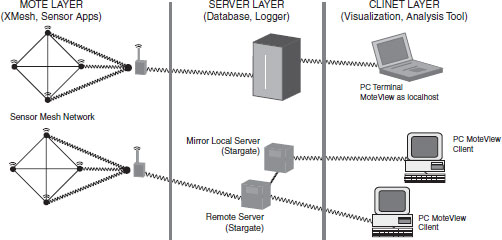Chapter 3
Sensor Technology
Never before in history has innovation offered promise of so much to so many in so short a time.
—Bill Gates
A typical wireless sensor network consists of spatially distributed sensors that cooperatively monitor some physical phenomena. This network formed by the sensors could contain nodes with varying capabilities and sometimes completely different underlying platforms, which must collaborate and communicate with each other. There are several advanced research platforms for wireless sensor networks in use by researchers globally with each platform offering unique differentiators such as sensor size, power consumption, nature of operating system, or basic sensing abilities [10,9]. In this chapter, we examine some sensor platforms and their associated software tools commonly in use today. Most tools used in the management of wireless sensor networks can be classified into three distinct categories (see also Fig. 3.1):
FIGURE 3.1 Networking structure of a distributed sensor network.

- Sensor level
- Server level
- Client level
3.1 SENSOR LEVEL
This level consists of devices that measure some physical phenomena or quantity such as sound, motion, light intensity, or temperature and convert it into some quantifiable form that can then be read by devices or human observers. Each sensor’s mote contains an onboard sensing, communication, power, and processing ...

